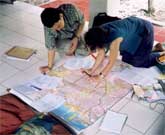This page provides links to a number of guidelines and other resources to help with HIV surveillance, and with the use of surveillance data for programme planning and monitoring. The selection is biased towards tools most useful for epidemics in which HIV remains concentrated among people who buy and sell sex, drug injectors and men who have sex with men. Note that the copyright for many of these publications is held by the publishing organisation. |
DRAFT: Back to Basics. A resource manual for planning and tracking effective HIV prevention efforts in adults
|
World Health Organisation. This is a DRAFT for field testing, not an official WHOdocument. |
A short DRAFT manual that helps HIV prevention programme managers to understand which populations are most likely to be exposed to HIV in the local situation, and which prevention programme elements would do most to reduce that exposure. The draft manual comes with a spreadsheet for calculating exposure, and step by step instructions for using the spreadsheet. This maual is being field tested, and feedback is actively welcomed. |
First Things First: Guidelines on management and coding of behavioural surveillance data |
Family Health International, Bangkok, 2006 |
Detailed technical guidleines for data managers. Prepared at the request of the WHO/UNAIDS surveillance working group, these guidelines provide data managers with information on how to create datasets which will meet the needs of HIV prevention and care programme managers, so that surveillance data can easily be translated into improvements in services. They also contain useful information on questionnaire design and data entry |
Guidelines for the effective use of data from surveillance systems |
WHO/UNAIDS, Geneva, 2003 |
Part of the WHO/UNAIDS series of technical guidelines for HIV surveillance, this document gives guidance on how to use the output of national surveillance systems for advocacy, programme planning and monitoring and evaluation. It contains practical advice on data presentation and the packaging of data into compelling and actionable messages for different audiences, including politicians, affected populations and the press. |
Estimating the size of populations at risk for HIV: Issues and methods |
WHO/UNAIDS/Family Health International, Bangkok and Geneva, 2003 |
| Recognising the increasing importance of accurate population size estimates in planning and evaluating HIV interventions, this guide for the first time brings together various methodologies that can be used to estimate the size of populations with behaviours that carry a high risk of HIV infection. It discusses the strengths and weaknesses of various methods, and is filled with examples and training exercises
|
Estimating HIV infection in a concentrated epidemic: Lessons from Indonesia |
UNAIDS, Geneva, 2003 |
Part of the UNAIDS Best Practice collection, this account details the process and the results of the first attempt to derive estimates of HIV infection based on rigorously documented, data based estimates of the size of at-risk populations in Indonesia. Indonesia, the world's fourth most populous nation, was the first country with a concentrated epidemic to base national estimates on provincial-level data.
|
National AIDS Programmes: a Guide to Monitoring and Evaluation |
| UNAIDS/MEASURE Evaluation, Chapel Hill NC, 2000 |
Dated and biased towards the needs of sub-Saharan Africa, this guide nonetheless contains some useful background material. The product of a global effort to bring together the needs of developing countries and donors in tracking the success of AIDS prevention and care programmes. The guide discusses the most rational use of resources in creating a co-ordinated monitoring and evaluation system. It reviews measurement challenges and proposes indicators appropriate to different epidemic states. |
Behavioural Surveillance Surveys: Guidelines for repeated behavioural surveys in populations at risk of HIV |
Family Health International, Bangkok, 2000 |
Technical guidelines for repeat surveys of HIV-related risk behaviours. This document, which provides information on sampling, data analysis, and other aspects of survey implementation, aims to guide those conducting behavioural surveys in sub-populations at risk for HIV. Many advances in methodology have been made since this guide was written, but it remains the best single overview of the behavioural surveillance process. While it provides model questionnaires, these have long been superceded in practice. |
Guidelines for Second Generation HIV Surveillance |
WHO/UNAIDS, Geneva, 2000 |
These guidelines -- the first to describe a more comprehensive approach to HIV and behavioural surveillance -- aim to improve resource allocation and data collection for more effective monitoring of national HIV epidemics. They focus on tailoring surveillance to the epidemic type, and on integrating behavioural and sero-surveillance.
|
Biological and Clinical Data Collection in Population Surveys in Less Developed Countries |
MEASURE Evaluation, Chapel Hill, 2000 |
Arising from a meeting at the U.S. National Academy of Sciences, this document reviews technical and ethical challenges involved in expanding population and health surveys to include biological and clinical data. It makes recommendations for necessary preparatory steps for any such expansion. Since the document was written several major surveys - including the Demographic and Health Survey series - have integrated biomarkers. It remains a good overview of the challenges that need to be considered in this area.
|
HIV surveillance: A global perspective |
Pisani E, Lazzari S, Walker N, Schwartländer B. 2003. HIV surveillance: A global perspective. Journal of Acquired Immune Deficiency Syndromes. 2003, 32: S3-S11 |
A summary of developments in the field of HIV surveillance, focusing in particular on the development of second generation surveillance systems. For related documents see the surveillance pages. |
HIV surveillance in hard-to-reach populations |
Schwartländer B, Ghys P, Pisani E et al. "HIV surveillance in hard-to-reach populations." AIDS 2001 15 (suppl 3) S 1-3 |
A summary of the major issues facing governments and other institutions in setting up systems to collect reliable information on HIV and STI prevalence and risk behaviours in sub-populations at high risk for HIV, in ways that are affordable and replicable over time. Populations discussed include injecting drug users, transgender, male and female sex workers and their clients and other men who have sex with men. |
HIV surveillance among female sex workers |
Ghys P, Jenkins C, Pisani E. "HIV surveillance among female sex workers". AIDS 2001 15 (S3) S33 - S40 |
This paper describes the issues facing those conducting HIV surveillance among female sex workers. It discusses ethical issues and data use as well as the challenges associated with getting reliable data that correctly records trends in infection, risk behaviour and prevention service use over time. |





